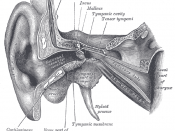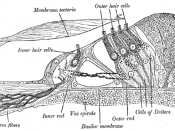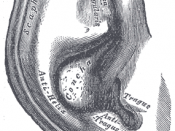Vibrations of air molecules moving through the air are received and translated into messages that the brain recognizes as sound by a complex organ--the ear. The ear has two important, but different, functions: hearing and sensing the body's equilibrium, or balance. The mechanisms for these processes are located within a hollow space in the skull's temporal bone.
Parts of the Ear and Hearing
The ear has three separate sections:the outer ear, the middle ear, and the inner ear. Each section performs a specific function, related to either hearing or balance. The three parts of the outer ear are the auricle (also called the pinna), the external auditory meatus (or ear canal), and the tympanic membrane (or eardrum).
The pinna collects sound waves from the air. It funnels them into a channellike tube, the external auditory meatus . This is a curved corridor that leads to the tympanic membrane.
The eardrum separates the external ear from the middle ear.
The middle ear is an irregular-shaped, air-filled space, about 0.75 inch (1.9 centimeters) high and 0.2 inch (0.5 centimeter) wide. A chainlike link of three tiny bones, the ossicles, spans the middle ear.
When sound waves strike the outer surface of the eardrum, it vibrates. These vibrations are mechanically transmitted through the middle ear by the ossicles. The malleus, or hammer, is the first ossicle to receive vibrations from the eardrum. It passes them to the second ossicle--the incus, or anvil. The third ossicle--the stapes or stirrup--relays the vibrations to a membrane that covers the opening into the inner ear. This opening is the round window.
Like the eardrum, the round window's membrane transmits vibrations. It directs vibrations into the inner ear, where they enter a fluid that fills a structure called the cochlea. This is a coiled tube that resembles a...



Good essay
this is a good essay but its also missing references. i doubt that this got an A+
0 out of 0 people found this comment useful.